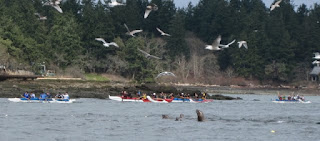 |
| [Photo: Stellar sea lions watching the race] |
 |
| [Photo: Outrigger making its way between the fleet] |
Crazy because the races had to find their way between: large fish boat;, smaller herring skiffs; anchored freighters; fish nets lurking just below the surface; rafts of sea lions; bobbing seals; and through flocks of birds. And the noise! Gulls crying, eagles calling and sea lions growling and belching! And crazy because I was piloting the safety boat, trying to stay ahead of the outriggers, out of their way, not run them over, keeping them all in sight, and, like them, avoiding the wildlife (one large sea lion jumped out of the water and almost landed on the bow of the boat!) and the fleet, and taking pictures at the same time. Crazy! Slideshow here.

